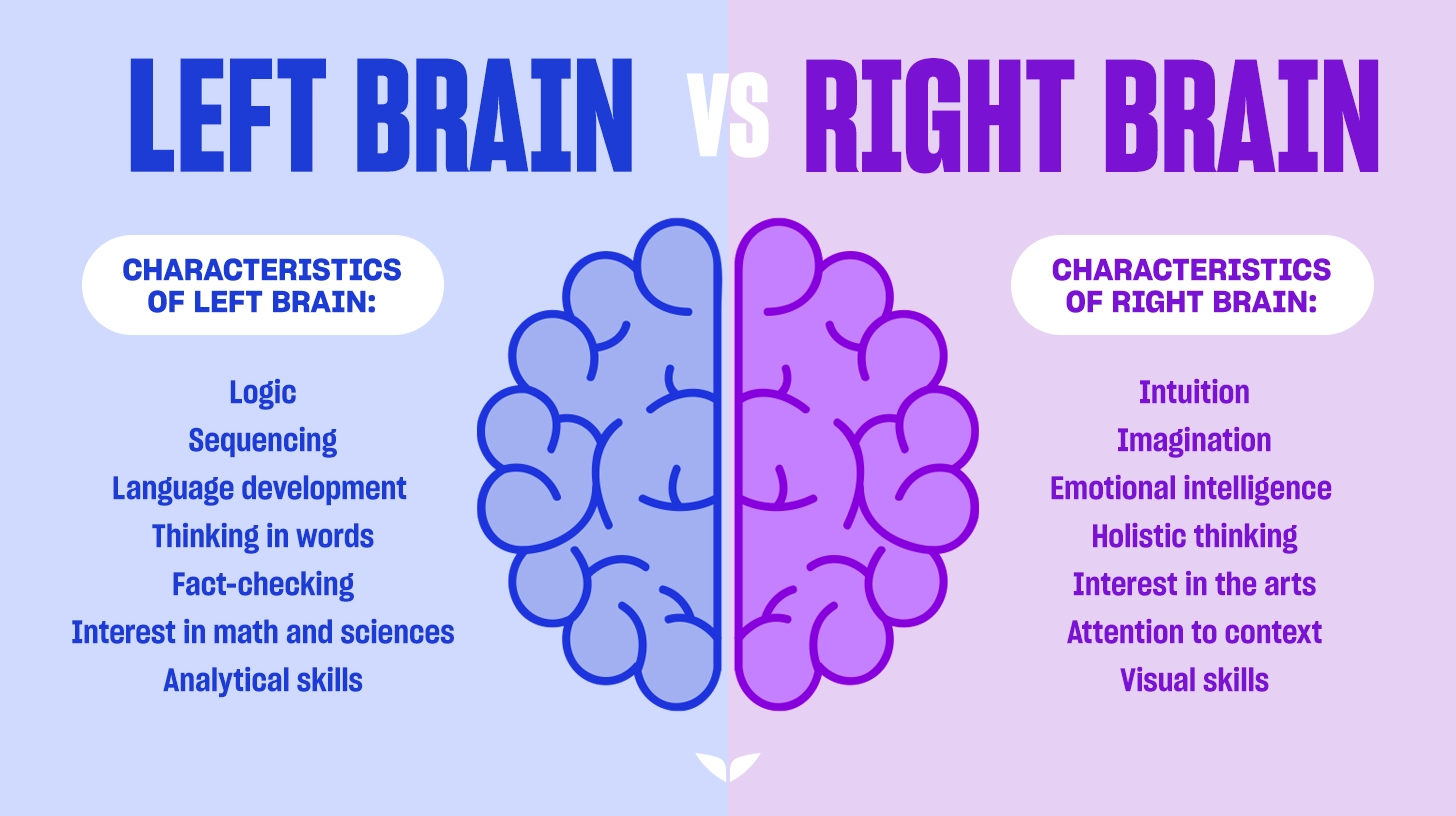From the way you feel to the way you think and act, your brain is a complex system that controls so much of who you are and what you do.
And we all use both sides of our brains 24/7. Or do we?
If that’s the case, how did the left brain vs. right brain argument come to be?
Do you really use one side of your brain more than the other? And what are the different characteristics of the two hemispheres?
Understanding how your brain works can actually help you “rewire” it.
As Jim Kwik, a renowned brain performance coach and trainer of Mindvalley’s Superbrain Quest, says, “We need to understand how our minds work so we can work our minds better.”
What Is the Main Part of the Brain?
To simply say that our brains are complicated would be an understatement. And they absolutely need to be. It’s hard work to keep someone alive.
The three main brain regions include the cerebellum, the brainstem, and the cerebrum.
The cerebrum is the biggest part of your brain, taking up more than 85% of its weight. And it’s responsible for regulating your emotions, reasoning, and learning.
In simple words, it’s what makes you, you.
It’s also divided into two cerebral hemispheres—the left and the right. (Fun fact: it’s the area of the brain we’re referring to when we say someone is right- or left-brained.)
Your left hemisphere controls the right side of your body, and vice versa. Hence the whole left-minded vs. right-minded debate.
What Are the Differences Between the Left and Right Brain?
Think of the left hemisphere as your go-to strategy game partner, always ready with a solid game plan. It is the center of your brain’s logical and “bookish” functions, helping you break down complex problems and find those “aha” moments.
On the other side, the right hemisphere is the more free-spirited side of your brain. It’s responsible for processing emotions and dealing with intuition.
While the left and right hemispheres of your brain don’t act independently, they are essentially polar opposites.
What Are the Characteristics of the Right Brain and Left Brain?
The left brain vs. right brain theory is heavily based on the fact that your two hemispheres function differently.
This first came to light in the 1960s. And that’s thanks to the research of psychobiologist and Nobel Prize winner Roger Wolcott Sperry.
Though much is still being learned about how the brain functions, here is what we do know about the difference between the left and right brains.

Left brain characteristics
Left-brain dominant people, by contrast, prefer cold, hard facts and real data.
They approach every potential risk with the necessary caution, and when facing problems, they try to find the most efficient solution based on logic.
Here are some key left brain characteristics:
- Logic
- Sequencing
- Language development
- Thinking in words
- Fact-checking
- Interest in math and sciences
- Analytical skills
They approach every potential risk with the necessary caution. And when facing problems, they try to find the most efficient solution based on logic.
Example of a left-brained person: The iconic book character Sherlock Holmes. He uses his power of analytical thinking to solve intricate mysteries.
Right brain characteristics
Right-brain dominant people are creative and free-spirited. Here are some key right brain characteristics:
- Intuition
- Imagination
- Emotional intelligence
- Holistic Thinking
- Interest in the arts
- Attention to context
- Visual skills
They don’t rely as much on logic or spend time weighing out the pros and cons of a situation. Instead, they make decisions based on their gut feelings.
Example of a right-brained person: Willy Wonka from the famous movie Charlie and the Chocolate Factory. Known for his creative approach to candy making, he often lets his imagination and intuition guide him along the way.
Scientific Studies About the Left Side of the Brain
The brain may be divided into two seemingly identical halves, but it is not exactly a mirror image.
Here are some of the functions that are processed more on the left side of your brain, according to science:
- The left side of the brain plays a pivotal role in language processing. Research suggests that left-side brain injuries can result in speech disorders, like the inability to speak or actively listen.
- According to studies, the left frontal lobe is more involved in logical thinking and analytical reasoning.
- Scientists have also found that “the human brain activates its left hemisphere more compared to the right hemisphere when solving arithmetic problems.”
Scientific Studies About the Right Side of the Brain
On the flip side, here are some of the functions that are processed more on the right side of your brain:
- Ever sensed danger before it happened? Scientists believe the right hemisphere of your brain is home to your “Spidey Senses,” also known as your intuition.
- Research has also proven that there’s a general dominance of the right hemisphere for all emotional functions.
- Based on reviews of numerous studies, the ability to produce and respond to music is associated with the right side of your brain.
- Your right brain also helps you navigate through your house without bumping into furniture. According to studies, it is the more dominant hemisphere when it comes to visual and spatial processing.
Is It Better to Be Left-Brained or Right-Brained?
There’s no difference if you’re more left-brained or right-brained. However, by embracing your right and left brains, you can analyze situations, taking into account both your emotions and your logic.
So, if you’re more analytical, try enrolling in a painting or sculpture class. Any form of art lesson that provides clear instructions can be a great way to dip your feet into the right side of your brain.
If you’re a right-brain thinker who thrives on creativity, chances are organization isn’t your strongest point. But it doesn’t mean you’re “programmed” to be like that forever (unless you want to).
For example, you can start simply by putting sticky notes in your work area to monitor your tasks.
Remember: You can always get out of your little box by practicing both left and right brain activities.
Take the “Left Brain and Right Brain Test”
Want to know which side of your brain you “wake up on” every morning?
If you’re curious, take this right brain vs. left brain test and find out your results right away.

Supercharge Both Sides of Your Brain
Just like all muscles, your brain can be made stronger too.
Continuously challenging and exposing yourself to new things will bring you one step closer to unlocking your mind’s full potential.
And if you’re ready to give both sides of your brain the workout they need, consider joining Mindvalley’s free Superbrain Masterclass with Jim Kwik. Through this exclusive, 82-minute masterclass, you’ll discover hacks and techniques to help unleash your superhuman memory, focus, and learning speed.
Take it from the over three million students who’ve participated in the program, like this Mindvalley Member:
“I rekindled the joy of learning very quickly and felt the brain fog lift. It literally blew my mind how quickly I was able to learn and memorize things… I save so much time in my work as a result, and I can be much more effective in what I do as well.”
— Dr. Vegard Engen, manager, teacher, researcher, and holistic therapist; Bournemouth, United Kingdom
Don’t underestimate your ability to push past what you know and make yourself smarter. Rip off that label, starting today.
Welcome in.
—
Images generated on Midjourney.








